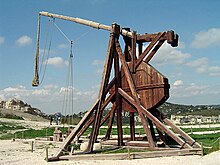Gravitational potential energy
Main articles: Gravitational potential and Gravitational energy
Gravitational energy is the potential energy associated with gravitational force. If an object falls from one point to another point inside a gravitational field, the force of gravity will do positive work on the object, and the gravitational potential energy will decrease by the same amount. The gravitational force keeps the planets in orbit around the Sun
A trebuchet uses the gravitational potential energy of the counterweight to throw projectiles over long distances
The factors that affect an object's gravitational potential energy are its height relative to some reference point, its mass, and the strength of the gravitational field it is in. Thus, a book lying on a table has less gravitational potential energy than the same book on top of a taller cupboard, and less gravitational potential energy than a heavier book lying on the same table. An object at a certain height above the Moon's surface has less gravitational potential energy than at the same height above the Earth's surface because the Moon's gravity is weaker. Note that "height" in the common sense of the term cannot be used for gravitational potential energy calculations when gravity is not assumed to be a constant. The following sections provide more detail.


No comments:
Post a Comment